One hundred years ago, Vermilion’s first public library was officially established when the Vermilion school board appointed a new board of trustees to oversee a town library.
Those are the facts. But there’s so much more to this story, which has been archived by Ritter Public Library, local historian Rich Tarrant of the Vermilion History Museum and the Vermilion Area Archival Society.
The story actually begins with a small group of women determined to bring a public library to their town.
These women persisted in their dream to see a public library established in the village of Vermilion. For nearly 40 years, they worked to bring books to the town, then make the books available to all who were interested, and finally – despite the turmoil of the years leading up to and including the Great Depression – to raise the money to establish the Vermilion Public Library.
1877 - A Prequel
In 1877, before Vermilion had a library of any kind, it had a reading room – a public location where citizens could go to read shared materials. Vermilion’s local newspaper, “The Vermilion Bugle”, announced, “Three cheers for the reading room! A great success!
“Yes, indeed! The Reading Room project is a success, and Vermilion may hereafter pride herself as regards this… The nice, large and commodious room in the front part of the Sturdevant block (on Liberty Avenue) has been refitted and rendered convenient for the purpose. Tables will be made for receiving the periodicals and papers and everything possible will be done to make it comfortable.
“A number of excellent papers have been secured free gratis and others will undoubtedly be had in the same manner. It is to be free to all who desire to drop in and spend a short time profitably, but, of course, all donations will be gratefully received. This is certainly a time for all to show their generosity by contributing liberally to the enterprise. Take hold friends.”
1901 - The Beginning
In 1901, the small fishing village of Vermilion was growing. The Lake Shore Electric railway had come through town providing a link to Toledo and Cleveland and that same summer, there was another special delivery.
Two gentlemen from Oberlin, recorded in history as Mr. Upton and Mr. MacIntosh, had solicited 100 people to sign up for a library, according to the town newspaper. About 200 books were delivered to the Nuhn and Trinter’s store on what is now Main Street.
“The books are ready to give out,” the paper noted in August, 1901. “Each member has the privilege of drawing one book at a time and retaining it for a period of two weeks. The books are nicely bound and a large percent of them right up to date. In fact, the selection is very good indeed.”
So before Vermilion had a public library, interested townspeople could pay to belong to what was known as a “subscription” library. This first library was the project of a small group of devoted women.
Here’s how it began:
In 1893, a women’s club was formed in Vermilion. It was called Sorosis, a branch of the first professional women’s club in the U.S.
The name Sorosis comes from the Latin word meaning sisterhood. The clubs were established to further the educational and social activities of women and “to bring together for mutual helpfulness, representative women in art, literature, science and kindred pursuits.”
The club’s motto was, “There is a woman at the head of all great things.”
Linda Ehrnschwender, information desk associate at Ritter Public Library, researched the club’s history. “It is said that at least 75 percent of all of the first libraries in towns all over America were founded due to the persistence of women in these clubs,” according to Ann Dodds Costello, author of “Smart Women: The Search for America’s All-Women Study Clubs”. In Vermilion, two hardworking women were members of the local Sorosis Club. Their families still reside in our town.
Mary Shaw became the mother of current lifelong resident Judy Williams and grandmother of the Karen Rossi family.
Bessie Roscoe was the wife and partner of Pearl Roscoe, owner, editor and publisher of Vermilion’s newspaper, “The Vermilion News”. Bessie became the grandmother of Rich Tarrant, who today serves as proprietor of the Vermilion History Museum on Grand Street.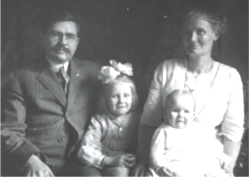
Bessie and her husband Pearl recorded the growth of Vermilion’s library in dozens of articles written for the newspaper. And shining through every article was clear support for the library from the newspaper’s publishers.
In 1901, an editorial in the paper stated, “It has been suggested that the subject of a library be brought before the public. We are of the opinion that this would be a good thing.
“A library not only gives the citizens of the community an opportunity of enjoyable and profitable reading, but gives the pupils of the schools a chance to obtain helps in their work which are too expensive for each to purchase.
“There are several ways in which such a library might be started. There are probably few families but what have one or two good readable books which they would gladly donate to push the thing along. Again, during the summer, the hundreds of visitors would be pleased and probably contribute their mite toward such an institution.”
In 1902, the idea of a library had taken root, with lots of help from the Roscoes.
“We now have the prospects of having a library in Vermilion,” according to “The Vermilion News” in December, 1902, “something that every village or city needs. It enables a person to have a considerable quantity of reading at a small cost.
“We can while away winter evenings to no better advantage, especially during the stormy weather, than to sit by our own fireside and read some good books. It not only relieves our minds of the cares of the day but also brings bodily refreshment as well.”
It’s clear the Roscoes could appreciate the warmth of a good book on a cold evening. They also knew the value of a good bargain.
“Already between 50 and 60 persons have become members of this Library Association and anyone who wishes may join by paying the required amount. Another feature is the cheapness. Where can we find so much good reading for so little money?
“Think this matter over and don’t delay,” the newspaper urged. “Join the subscribers’ library at the earliest opportunity. Don’t wait to be invited personally.”
Through the early 1900s, Vermilion’s subscribers’ library consisted of shelves of books housed in various local businesses. In 1903, the books were located at Penning’s News Stand and then at Harris’ Drug Store.
“We have a good start for a library,” the paper stated that year, “and if those interested will be patient and give their undivided support to a home institution, we will in a few years have a library to which we can point with pride… At the present price at which good books can be purchased, $1 per year should be sufficient.”
The newspaper was sure Vermilion could handle the task.
“We believe the people of Vermilion are capable of selecting their own books and not dependent on someone with a well-learned lesson concerning up-to-date reading. A comparison of our home library with any other of similar size will furnish the doubter with much food for thought. With a home library, we pay for the books and have the privilege of reading them, besides they remain in the village for the use of others.
“Think the matter over and put your name down for another year. Also, try to induce your neighbor to do likewise.”
Just a few months later, the books moved to Nielsen’s Jewelry Store. In 1904, there were 66 members “with others joining daily.”
“The Vermilion News” reported, “The library is in splendid condition after one year’s use. Not a single book of the entire 160 or 170 books but that (are) in this library or in use by some member that can be accounted for.”
But overdue fines already existed!
“Each member of the association should read the rules governing the use of books, which they will find pasted on the inside cover of each book, thus avoiding any misunderstanding that might arise concerning the payment of fines for keeping a book overtime, etc.”
To ease community relations, a notice from the association admonished, “Remember that it is the Association that governs this and not the Librarian neither the Custodian of the books.”
In 1907, Bessie Roscoe was president of the Subscribers’ Library Association. The subscription price for a year was $1. “We feel assured that any person can get their money’s worth. Do not wait to be asked to subscribe but call on the secretary or send money to her and receive your card.” Members were also busy fundraising. “A concert will be given for the benefit of the library at the town hall next Thursday,” according to an announcement in the newspaper. 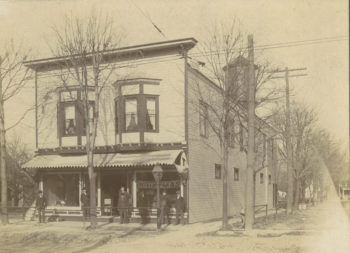
In 1908, the books moved from the jewelry store to the Guy Davis dry goods store on the northwest corner of Grand and Liberty streets (currently site of Friendship Park). Lending hours were one afternoon a week and Saturday evenings.
1912 - A Partnership
By the beginning of the 1900s, in Sandusky, the women of the city had organized their own library, taking advantage of a grant from Andrew Carnegie to build a permanent home for their collection. In 1912, the Sandusky Library Association made an agreement with Erie County Commissioners to grant full use of its collection to every resident in the county.
“The Vermilion News” reported, “The library at Sandusky (is) sending us a list of one hundred books with a general invitation to the public to use them freely.” At that time, “A librarian was appointed at a salary of fifty dollars per year, paid from the county fund.”
According to a Sandusky newspaper, Vermilion’s county library station was located in a private home and the librarian was Mrs. L.H. McQueen.
1918 - A Library of Our Own
In 1918, Vermilion’s library became official!
The president of Vermilion’s school board, A.C. Hofrichter, appointed the first library board of trustees, making it possible for the town to begin receiving state funds available for public libraries.
According to a report written by local resident Addie Rust, Bessie Roscoe and Mary Shaw were chosen from the Sorosis Club, Bertha Nieding and Maria Smith were selected from Vermilion High School Alumni, and Mamie Thompson and Addie herself were chosen from the Village of Vermilion. Rev. Howard Lynch, pastor of the Congregational Church, was also appointed.
Bessie Roscoe would continue to serve on the library board for the next 26 years.
Ella Buttner was librarian for a year and in 1920, Cora McQueen became librarian. In 1935, Rust said that McQueen “has held that position ever since, some fifteen years and this past two weeks is the only time she has been off duty, and that on account of illness.”
Betty Trinter, author of “The Way It Was: Vermilion 1807-1984”, takes over the story now:
“Their goal was a public library building to house the books and periodicals that through the years had been donated by Vermilion citizens, and more recently been offered by the Sandusky Library system. Until this goal was reached, Mr. C.A. Mattison, local jeweler, offered the use of his rooms two days a week.
“It wasn’t long before money raising efforts began. A concert was held at the Opera House (all home talent), and sometime later the Congregational Church had a Maypole Dance in the town hall, put on by the children, under the direction of Mrs. Hattie Ries and Mamie Thompson.”
By 1920, the village of Vermilion was bustling. It was host to thousands of summer visitors who came to picnic and play at the popular Crystal Beach Park. And town leaders were making plans, Trinter wrote.
“Then came a new idea, the proposal of a $25,000 brick building in Exchange Park to be used as a gym, library and a memorial to the Vermilion soldiers and sailors.”
According to Trinter, the town voted down plans for the new building, but the library board persisted in its search for a more permanent home.
In 1920, the Vermilion Public Library began renting space in a building that also housed a photography studio owned by Rudy Moc.
This first official library building was located on the east side of Grand Street 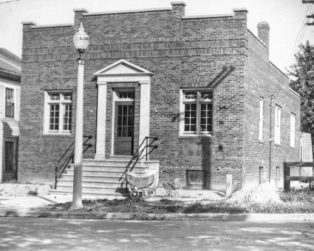 just north of the railroad tracks. Trinter wrote, “At an earlier date, it had been a blacksmith shop. The pleasant frame building with the skylight on one side was often referred to as the reading room.”
just north of the railroad tracks. Trinter wrote, “At an earlier date, it had been a blacksmith shop. The pleasant frame building with the skylight on one side was often referred to as the reading room.”
On Dec. 4, 1920, a formal opening was held and “Mrs. Shaw donated curtains for the windows and the room was set in order for the guests,” Addie Rust reported.
During those first few years, Rust wrote, “The amount from the taxes was not enough to carry on the work so various plans were discussed as to how to increase the funds and several social affairs were given.
“A community party was held in the town hall with refreshments served in the parlors of the Congregational Church, proceeds $20.10; Mrs. W.G. Hauff kindly came to our rescue and on two different occasions gave an entertainment, the proceeds … which she very gladly turned over to the board; and the Good Government League gave $174.50.”
Other donations during those years came from the Sorosis Club and “The Vermilion News”, as well as local residents. In 1929, Moc moved to Lorain and the library board purchased the building on Grand Street for $1,550.
Some Pointed Nudging
During this period, historian Rich Tarrant records, his grandmother Bessie spent her days working at the news desk, writing, answering calls and tending to the business needs of the paper and the print shop. The family apartment was upstairs and her two daughters, Ella and Alice, often joined their mother on the first floor as she worked.
Ella grew up to become business manager and lead news writer for the paper, as well as Rich’s mother. He recalls his mother recounting a running back-and-forth conversation between Bessie and a man named George Ritter.
Anytime Bessie would encounter Ritter, who’d grown up in 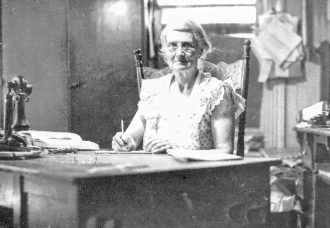 town and was at that time establishing a very successful law practice in Toledo, she’d be sure to remind him of the library’s financial need. The book collection was growing and the board hoped to replace its modest wood-frame building with a modern structure built specifically for the needs of a library.
town and was at that time establishing a very successful law practice in Toledo, she’d be sure to remind him of the library’s financial need. The book collection was growing and the board hoped to replace its modest wood-frame building with a modern structure built specifically for the needs of a library.
According to Tarrant, Bessie’s repeated reminders went unanswered. Nevertheless, the board continued to save and invest, scrimp on spending, and hold fundraisers including concerts and other community entertainments.
Tarrant points out how especially difficult this might have been in the early 1930s. The stock market crash of 1929 kicked off a severe worldwide economic depression that lasted throughout the coming decade. Personal income, tax revenue and profits dropped, and unemployment in the U.S. rose to 25 percent.
During these years of strife, “The Vermilion News” reported, “The Library Board spent many hours planning and cutting corners to add to their building fund. Miss Ida McCague, although not a member of the board, saved many pennies for the building fund by obtaining copies of the latest books, slightly used, at a lower price… Mrs. Pearl Roscoe obtained the magazine subscriptions for the library, giving them the benefit of the publishers discount, which helped swell the building fund.”
1934 - A Home of Its Own
Despite the woes of the national economy, by 1934 the library board felt it had saved enough to construct a new building. The existing wooden building was dragged to the back of the property and later sold, and a new, brick building was erected in its place in early 1935.
According to local newspaper reports, some of the labor 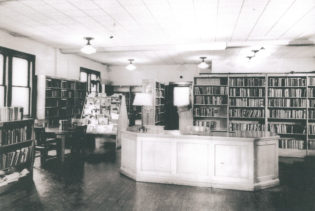 on the building was provided through the Federal Emergency Relief Administration, which was established by President Franklin Roosevelt to support the unemployed. Local contractor W. Tischer was in charge of the project.
on the building was provided through the Federal Emergency Relief Administration, which was established by President Franklin Roosevelt to support the unemployed. Local contractor W. Tischer was in charge of the project.
“The building will be 32 x 48 with a nine-foot basement under all and will comply strictly to state code. It will be a one-story affair of brick and tile, well lighted,” the paper said. The building still exists, as The Old Vermilion Jailhouse Bed and Breakfast.
Staunch support continued to stream from the Roscoes through the pages of “The Vermilion News”.
“Does a Library in Vermilion Mean Anything to You?” reads the headline in a story from September, 1935. “Patrons of the public library are being served from the new building this week although there is considerable finishing work to be done and still some unpaid bills, which the board is very anxious to clear up before the formal opening next month.” After listing several donations ranging from $1 to $5, the article reminded, “There is still plenty of room for contributions.”
The new building was officially opened with a formal ceremony on Oct. 19, 1935. Paul Noon, the state librarian, attended from Columbus with some “splendid advice. He admonished the board that a library is not a Sunday School and books and magazines in popular demand should be selected.”
1930s and ’40s - Time of Growth and Loss
Janet Ford, Vermilion’s library director from 1981-2015, said furniture for the new building was built to specifications and at low cost at the Ohio State Reformatory. In 1936, Cora McQueen resigned because of poor health and Jean Lawless, “who was trained in library work”, became the next librarian.
The town continued to grow. In the mid-30s, all Vermilion students attended school at a newly expanded brick building on South Street. The wooden lighthouse that stood at the mouth of the Vermilion River was replaced with a new, “modern” structure made of steel.
The library collection, which comprised 7,000 items in 1935, was growing too. In the 1940s, a patron could browse nautical books on the Wakefield Shelf, art and music items from the Glen Johnson Memorial collection, and books about South America on the Pittman Memorial Shelf. A shelf of technical books for the layman was also added.
In 1946, Bessie Roscoe died and a memorial fund was established to benefit the library. Tarrant regrets that his grandmother didn’t live to see George Ritter’s great gift to the town.
1950s - A New Era
World events continued to affect life in Vermilion and the progress of its library, according to Ford’s research. In Toledo, George Ritter had made a very important move in 1925. He became legal counsel to the founder of the Willys-Overland Co. in Toledo, which in the 1920s was the second largest automobile manufacturing plant in America.
After years of turmoil for the company, Ritter was part of a team in 1936 that helped re-organize it. Learning from opportunities missed by Willys during World War I, they led a changeover that helped the company become the first manufacturing plant to be converted to war production, saving the company and also thousands of local jobs.
During the 1940s, the company produced gas shells, bullet cores, treads for tanks and gun hoists. But most importantly, the company produced one of the most valuable U.S. military machines – the Jeep.
Throughout this period, Ritter served as vice president and general counsel. After the war, in 1948, Ritter purchased the estate of the now-deceased founder, John Willys. His fortune was made.
In the 1950s, George Ritter began sharing his wealth. Did he remember his conversations over the years with Bessie Roscoe? In 1954, Ritter contacted the Vermilion library board with an offer to fund a new, larger building as a tribute to his parents.
He donated $150,000 in cash plus enough to purchase an additional 10 feet of land and $50,000 to purchase marble for the front and for six pillars. Correspondence between Ritter and the building architects show they chose pink marble over white, thinking the white marble wouldn’t retain its whiteness over the years.
The new building would have space for 25,000 books.
Its design was modeled after a mansion built by Joseph Swift along the Vermilion River south of town, in an area known locally as Swift’s Hollow. 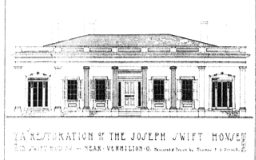 A local newspaper said in 1958, “One of Ohio’s prominent early homes, resplendent in state history, will ‘live’ again in the Vermilion area when the new Ritter Memorial Library here is constructed.”
A local newspaper said in 1958, “One of Ohio’s prominent early homes, resplendent in state history, will ‘live’ again in the Vermilion area when the new Ritter Memorial Library here is constructed.”
More than 30 tons of marble from Georgia would be crated in wood and trucked to Vermilion, along with 31 tons of limestone from Alabama. Each of the six columns across the front of the building would be assembled from three, precision-machined pieces weighing 3,500 pounds.
In the new building, “The Vermilion News” reported, “reading areas for adults and children will be separated by a screen. In addition to the main room, there will be a community meeting room furnished with a motion picture screen.”
“As good lighting is deemed important for better reading,” a news article said, the building would have fluorescent lights from Vermilion’s own F.W. Wakefield Brass Co.
Development of the project would not proceed without controversy, however. Before the first shovel of dirt was dug, trouble occurred as the school board, agent for the library, attempted to acquire the desired property along Liberty Avenue.
Local businessman Guy Walker owned a car dealership with lots on the corner of Washington and Liberty. He didn’t want to give up his option to expand his business and objected strongly when the school board consulted with the Erie County prosecutor about exercising its right to acquire the land over Walker’s objections. After a heated debate that was played out through letters to the local newspaper, the conflict was resolved and construction of the library got underway.
On a sunny day in May, 1958, a large group of residents gathered at the construction site as George and Mary Ritter returned to town to lay the building’s cornerstone.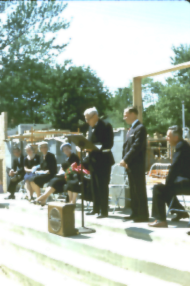
Ritter told the crowd of his boyhood wish that Vermilion could have a library and tipped his hat to the women of the town, noting that it was through their efforts that the first library was established.
“He pointed out that his parents had instilled in him early the belief in the American ideals of equal opportunity for success through integrity and industry, and the responsibility of each person to maintain these ideals for succeeding generations,” according to the newspaper.
The same year he told a group at Baldwin-Wallace College that he wanted to honor his parents “who showed me the opportunities for a poor boy in America. They also taught me that there are responsibilities as well as opportunities, and I resolved to render certain public services.”
As part of the ceremony in Vermilion, a sealed box was placed behind the cornerstone. In it are documents and newspaper stories and also a sealed letter written by George Ritter with instructions that it not be opened for 100 years.
In December of 1958 during a snowfall, residents of Vermilion pitched in to move about 16,000 library books to their new home. Youths, members of the Lions Club, the Piston Pushers, the Vermilion Junior Civic Club and others transported boxes and furniture from Grand Street to Liberty Avenue, where women worked re-shelving the collection.
Although Bessie Roscoe had long since passed away, her spirit was still alive in the beautiful building – the new children’s department was furnished in part thanks to funds from the Bessie Roscoe Memorial Fund.
1960s, ’70s and ’80s - Still Growing
In the early 1960s, the library had about 23,000 volumes and the new community room was well-used for recitals, films and various meetings. Librarian Delores Warburton showed a series of travelogue films during the winter months. But by 1966, the collection had outgrown its shelves and the community room was converted to a reference room.
In 1977, George Ritter returned to the library board of trustees with an offer to help fund an expansion of the building. Talks began but in 1979, Ritter died. He included Ritter Public Library in his will and asked that an addition be named to honor his sister, Allie.
Construction began in 1982, adding about 5,000 square feet and creating a second entrance on the north side of the building on Ferry Street, which allowed for easier access for handicapped patrons. A small community room provided seating for about 35 people and a new skylight joined the old and new sections, creating a sense of openness.
George Ritter’s will also named the library as beneficiary of a trust that will continue to provide income to the library in perpetuity. In 1985, his generosity was once again a boon to Vermilion residents. Proceeds from the trust, amounting to $20,000, allowed the library to purchase membership in the CLEVNET library partnership, which gives Ritter customers access to 12 million items from 44 different library systems across northern Ohio.
1990s - Technology Arrives
By 1990, the library had once again outgrown its space. The building was not wired for technology, nor was there a practical division of space for the different areas of the collection. Trustees conducted a survey of current and future needs, and determined the building could be expanded again, this time out to the property lines with a partial basement.
This time, trustees sought support from the community. For the first time since the library was established, two issues were put before the voters. One was a bond issue to build the expansion and the second was an operating levy to help with the daily expenses. In November 1992, both issues passed.
To prepare for construction, the entire library was moved to the old Valley View School on Beechview Drive in 1993 and was operated from that facility for one year. In November 1994, the library re-opened on Liberty Avenue. Vermilion City Council agreed to close Washington Street to the west and property was purchased for additional parking.
2000s - Center of the Community
With an eye to the future, library trustees bought property in 2002 on Liberty Avenue immediately east of the current building for future expansion. The property had been the site of the Dick Baker Dodge car dealership. The library began using the old car showroom there – which became known as the annex – to provide increased meeting space for community groups.
After four years of increasing use, however, the annex was 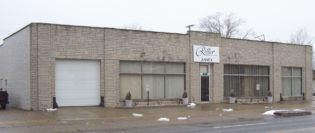 badly in need of repairs. Trustees had to decide if they should repair and remodel or if it would be more cost-effective to raze the building and construct new space.
badly in need of repairs. Trustees had to decide if they should repair and remodel or if it would be more cost-effective to raze the building and construct new space.
A public survey in 2006 showed residents wanted more from their library – more meeting space, more public computers and more space for teens and other services. In November 2007, voters approved two issues. A new bond issue for new construction replaced the previous bond, which had been paid off early. And the library’s continuing operating levy was replaced, to be collected at current property values.
The annex was demolished in December 2008 and construction of the new addition, including a second floor and partial basement, got underway in March 2009. The project was completed and celebrated with a grand opening ceremony in March 2010.
The expansion added 18,000 square feet of new space, including a new community room and other meeting spaces; a 26-station computer lab; and expanded spaces for children, teens and adults.
Ritter became the first public library in Ohio to earn a gold award for Leadership in Energy & Environmental Design (LEED) when the U.S. Green Building Council recognized the many green designs in the building addition in 2011. The designs include a rain garden in the front yard and a green roof, a porous parking lot, a cistern, and energy-efficient lighting and heating and cooling systems.
Today, the library is the only location in Vermilion providing free access to the internet on public computers. Residents use free internet at Ritter more than 100 times every day.
Ritter has more than 350 visits every day and serves about1,250 people every month with public programs, classes, storytimes, meeting space and more.
As Ritter Public Library celebrates its centennial in 2018, we recognize Bessie Roscoe and the women of the village, hometown son George Ritter, and also the residents of Vermilion today who continue to make the library the center of our community.

